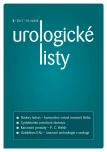Rare complicaton of insertion double J stent – migration to right heart atrium
Authors:
R. Hrabec; P. Trojan; P. Filipenský; P. Řehořek; P. Malík
Published in:
Urol List 2012; 10(3): 56-58
Overview
We report a case of extremely rare complication of insertion double J stent, which is a very frequent endoscopic procedure as a derivation of urine from upper urinary tract. Our case report involves rare event of total migration of double J stent from urinary tract to the inferior vena cava and right heart atrium due to anomaly of vena cava. Double J stent was inserted because of urine leakage after panhysterectomy for carcinoma of cervix.
Key words:
double J stent, inferior vena cava, hydronephrosis
Sources
1. Pearle MS, Pierce HL, Miller GL et al. Optimal method of urgent decompression of the collecting system for obstruction and infection due to ureteral calculi. J Urol 1998; 160(4): 1260–1264.
2. Mokhmalji H, Braun PM, Portillo FJ et al. Percutaneous nephrostomy versus ureteral stents for diversion of hydronephrosis caused by stones: A prospective, randomized clinical trial. J Urol 2001; 165(4): 1088–1092.
3. Zachoval R, Urban M, Záleský M et al. Double J-stent versus nefrostomie při drenáži horních močových cest, Urol List 2004; 2(2): 43–46.
4. Joshi HB, Newns N, Stainthorpe A et al. Ureteral stent symptom questionnaire: development and validation of a multidimensional quality of life measure. J Urol 2003; 169(3): 1060–1064.
5. Slaton JW, Kropp KA. Proximal ureteral stent migration: An avoidable complication? J Urol 1996; 155(1): 58–61.
6. Falahatkar S, Hemmati H, Gholamjani Moghaddam K. Intracaval migration: an uncommon complication of ureteral Double-J stent placement. J Endourol 2012; 26(2): 119–121.
7. Ng WT, Ng SS. Double inferior vena cava: a report of three cases. Singapore Med J 2009; 50(6): 211–213.
Labels
Paediatric urologist UrologyArticle was published in
Urological Journal

2012 Issue 3
Most read in this issue
- Rare complicaton of insertion double J stent – migration to right heart atrium
- Continent and incontinent urinary diversion, bladder sparing approaches
- Current view on small renal masses
- Robot assisted radical cystectomy: the Mayo Clinic technique
